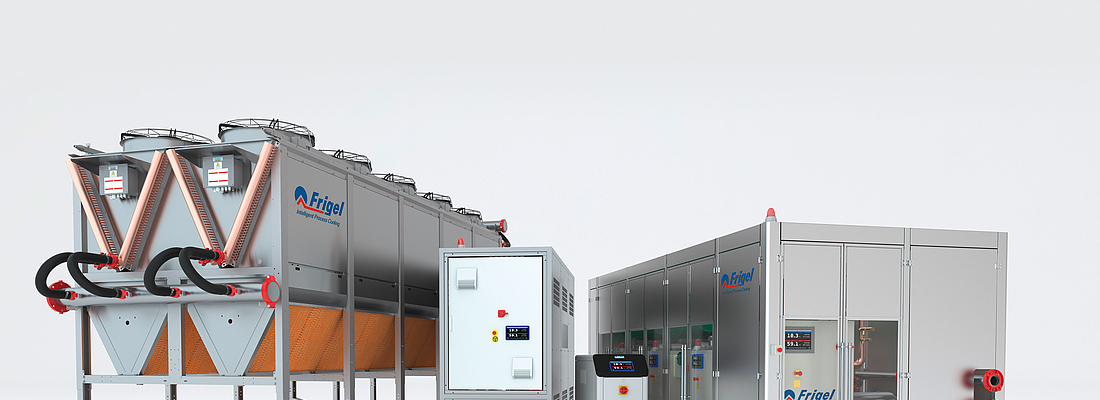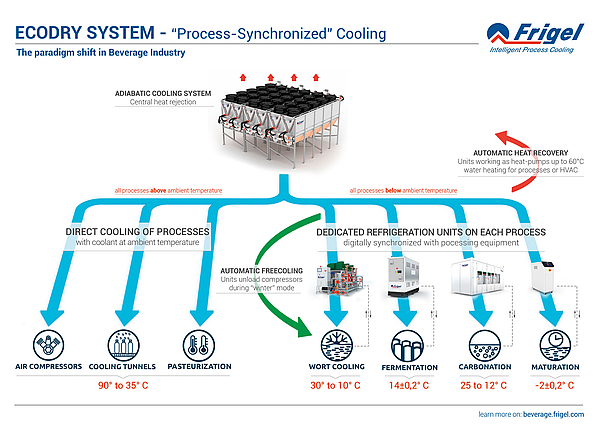

For decades and despite tremendous technological progress in all aspects of beverage processing, the “Central Refrigeration Plant” has been and still is the most common solution to all process cooling requirements in the industry.
THE OLD WAY
It is well known that cooling has a very large impact on beverage businesses. From product manufacturing to bottling, productivity, running costs and environmental impact are heavily affected by cooling performance.
Traditional central systems are basically designed to produce and distribute cooling to a variety of different processes. Even though each process would have its specifics needs, the central system would supply the same cooling conditions to all of them by pumping from the distant “utilities area”, a large over-flow of coolant at the minimum temperature required among them. Then each process will control the flow of coolant according to its specifics needs thus creating fluctuating conditions to the whole systems flow and affecting the stability of the other processes.
In few words, central cooling has always been conceived as a “factory utility”, an extremely “rigid” solution and a system very difficult to balance, running at low levels of overall efficiency.
In an Industry where “synchronization in everything”, there is still no “link” between cooling and processing equipment. On the other hand, refrigeration plants are extremely expensive to run. By operating large capacity installed at very low temperature and using evaporative heat rejection systems, they generally represent the highest share of overall electrical and water consumption in a beverage facility, thus resulting in systems with a very high Environmental Impact in terms of both Carbon and Water foot-prints. Moreover, central systems are extremely complicated, engineering intensive, expensive to install and difficult to operate, maintain and expand. They typically run with large amounts of glycol and ammonia, which are becoming, more and more, a big issue in terms of both risks for the health and for the plants and their environment, not to mention the insurance costs to cover them.
THE INNOVATION
The Ecodry System is a new integrated cooling solution, based in an innovative engineering concept that truly represents a paradigm shift in beverage industry. From soft drinks to brewing, from manufacturing to bottling, this “Intelligent Process Cooling” approach can cover all cooling demands with unbeatable performance improvements and savings when compared to tradition solution.
The System is based on two technologies:
1. “Process-Synchronized Refrigeration Units” (Microgel® and MutiStage®)
In this revolutionary approach, one cooling unit (chiller) is dedicated to each main processing line, specifically designed for the application in terms of cooling and pumping capacities. Super-compact, factory built and pretested, each cooling unit may have single-stage or multi-stage-cascade refrigeration circuits that operate inverter driven screw compressors with latest generation “green refrigerant” gas and inverter driven process pumps.
The units are easily installed and connected to each process, digitally-synchronized with the processing lines and automatically operated by them, delivering with high precision the set of cooling parameters (coolant temperature and flow rate) pre-programmed by the operator, according to the actual demand, adapting the logics of control to the specific requirements of the process, according to process status (ON/OFF, RUN/STOP, IDLE or CIP) at any given time.
Optionally, being the units water cooled chillers, they may also be operated as “heat-pumps” in order to easily get heat recovery, able to produce hot water (up to 60°C), to be used either for process purposes or room heating (HVAC) during winter.
2. “Central Adiabatic Cooling System” (Ecodry®)
To complete the Ecodry System innovation, the cooling units installed at each process are connected to a central adiabatic cooling system installed out-doors in order to reject to ambient the heat extracted from processes (if not recovered). This
modular system – alternative to old-style evaporative cooling towers - is made of close circuit adiabatic fluid coolers with large copper coils and aluminum finned-pack heat-exchangers and inverter driven DC-brushless fans, that can keep coolant temperature even lower than ambient temperature, thanks to the patented adiabatic chamber which, during high ambient temperature conditions, pre-cools the air before it reaches the heat exchangers.
Obviously, this central system can also provide direct cooling to all processes requiring temperatures above ambient, such as air compressors, cooling tunnels, pasteurizers, etc.
PERFORMANCE
The Ecodry System brings overall performance to a higher level in beverage manufacturing, based on: Increased productivity, highly reduced operating cost and total modularity.
Increased Productivity:
The process synchronized cooling guarantees, that each processing line always runs consistently at the highest throughput. In many beverage processes, especially those with a high cooling demand, an increased productivity of 20 to 30% can be achieved. This is due to four main reasons:
1. Maximum flexibility:
There is no limitation of settings of coolant temperature and flow rate delivered to each process. The user is able to research and find the cooling parameters that maximize the processing line speed for
each specific product. These parameters may be digitally memorized and restored any time the line manufactures again the same product.
2.Perfect Stability:
Each unit assures high precision in temperature control and constant flow rate of coolant to each process with complete independence - avoiding interference within users - while the processing equipment runs always steadily at the highest throughput.
3. Full automation and connectivity:
Each cooing Unit is automatically operated by the processing line, and is constantly communicating with it. It is able to start or change conditions extremely quickly because it operates with very low thermo inertial volumes of coolant, reducing rump-up times and any waiting dead-time during production stops, change of formats, change of product, etc.
4. High reliability:
The Ecodry System has high redundancy. On one side, dedicated Units are extremely reliable because they are factory built, in serial production, and pre-tested before shipping; they typically have multiple refrigeration stages and are generally designed with one back-up stage granting no production stop in case of failure of one compressor. Furthermore, each stage is basically an “extractable” self-supporting unit, that can be easily replaced. On the other, also the central adiabatic system will have multiple fans and pumps, easy replaceable in case of failure.
Reduced Operating Costs
The Ecodry System achieves remarkable running costs savings when compared to traditional central systems: Energy Savings (up to 30%), water savings (up to 95%) and overall maintenance & safety costs savings (up to 90%).

ENERGY SAVINGS (UP TO 30%)
The new system based on individual cooling units per each process, grants very high energy savings, due to four main reasons:
1. Higher overall refrigeration performance of System (EER/COP)
According to the requirements of the different processes in the facility each dedicated refrigeration unit will operate with differentiated coolant temperatures, thus running all of them, always at the maximum refrigeration performance rate. Whenever the process may run a product that allows a higher coolant temperature, the unit associated will automatically increase its efficiency. Additionally, the concept grants no consumptions - of any kind – when there’s no production.
2. Higher refrigeration efficiency of Cooling Units (EER/COP)
All units have last generation, high efficiency, variable speed refrigeration screw compressors and also frequency driven pumps, delivering a remarkable efficiency, especially at partial load operation. Additionally, for those processes with high temperature differential (difference between temperature of coolant returning from the process and temperature of coolant leaving to the process), the cooling units have multi-stage-cascade refrigeration, furthering improving the efficiency. Finally, installed close to process, Units perform with minimal thermal and mechanical losses through the piping distribution network, adding more energy savings.
3. Free-cooling opportunities (Optional)
This new system can take energy saving even further. The main concept is to use ambient air cooling instead of refrigeration whenever the ambient temperature allows to. For this purpose, the system integrates the adiabatic coolers with the refrigeration Units that have an additional feature: Automatic free-cooling mode. Whenever the coolant temperature returning from process is higher than the temperature supplied to the unit by the central adiabatic cooling system, the devise will automatically switch to free-cooling mode. The coolant returning from process will be diverted to the adiabatic coolers to be rejected in the ambient air with minimum energy consumption. As a result, the refrigeration compressors will be unloaded proportionally. In locations with frequently low ambient temperatures this unique feature may result in additional 20 to 30% energy savings.
4. Heat Recovery opportunities (Optional)
Being the units water cooled chillers, by operating them as heat-pumps, they may also be used for heating by recovering up to 100% of the heat taken from refrigeration loads. The hot water produced (up to 60°C) can be used for various purposes like pre-heating of water used in the beverage processes or for room heating during winter time, to the HVAC system.
WATER SAVINGS (UP TO 95%)
The System uses a central adiabatic cooling system for heat rejection of the whole thermal loads of the plant. This technology operates water evaporation only during short periods of time whenever ambient temperature is extreme (above 30°C). An “on demand” intelligent saving software – operates adiabatic mode only when needed, otherwise the system runs completely dry.
MAINTENANCE & SAFETY COSTS SAVINGS (UP TO 90%)
The refrigeration units are made of relatively small chillers, which require low expertise to maintain or repair. The chillers are built with leakage-free refrigeration circuits, which makes them almost maintenance free. Operating with innocuous gases they do not require any specific safety infrastructure, saving all costs involved including safety insurance policies. On the other side, the central adiabatic system is a close loop circuit that grants excellent heat transfer with maintenance- free coolant, avoiding scale accumulation, with no need of ongoing water treatment.
Total Modularity
This modular and plug&play concept has many additional
advantages compared to traditional system. It is easily expandable at any time, which allows the installation of the precise capacity needed at every stage of the plant growth. Thanks to its modularity, it is also extremely easy to gradually implement even in existing plants, one unit at a time, requiring low level of expertise to engineer, install and operate. Eventually, it could be partially o totally relocated. An additional advantage of this new concept is that it allows processors to know the “cost of refrigeration per line and per product” because each unit can measure and record the specific energy consumption per product (kwh/hl: kwh/m3: etc.)
SUSTAINABILITY
The Ecodry System achieves outstanding results in terms of environmental impact reduction. The main advantages are:
Reduced “CARBON FOOTPRINT” - up to 50% less
Thanks to its unbeatable refrigeration efficiency, free-cooling opportunities and the possibility of reducing gas consumption with the heat recovery option.
Almost no “WATER FOOTPRINT”– up to 95% less
Thanks to the Adiabatic Cooling Heat rejection technology, Beverage Industry may definitely arrive close to de 1:1 ratio.
Lowest “RISKS OF EMISIONS”
The System is Ammonia -free, operates innocuous refrigeration gas, with the lowest GWP available today and it is divided in several separated small circuits so the risks of emissions in case of leakage is reduced to a minimum.
Moreover, this system does not require of big thermal inertial central tanks and so operates with 90% less glycol than a central system. Additionally, it doesn’t dispose any chemicals from water treatment as evaporative cooling towers do.
The comPETence center provides your organisation with a dynamic, cost effective way to promote your products and services.

magazine
Find our premium articles, interviews, reports and more
in 3 issues in 2025.


